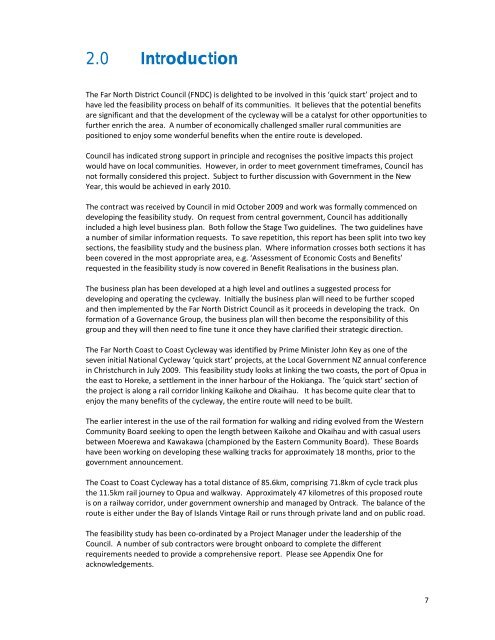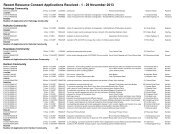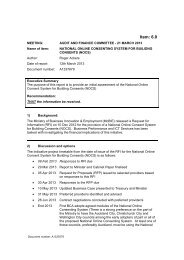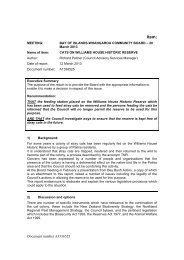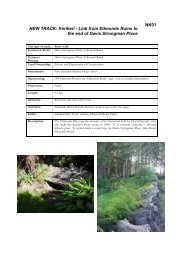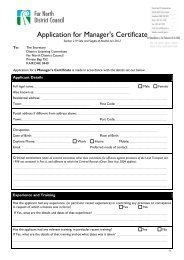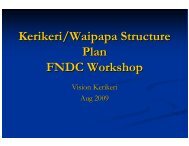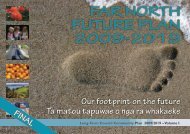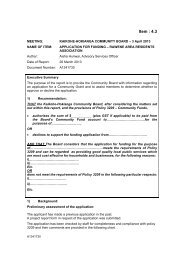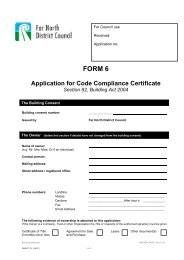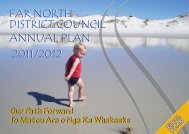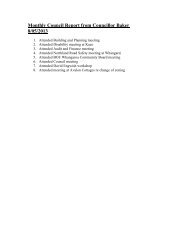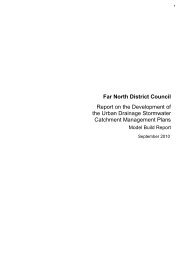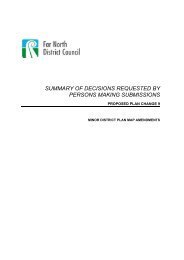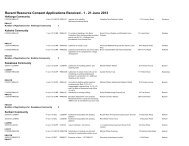Full Feasibility Study Report - Far North District Council
Full Feasibility Study Report - Far North District Council
Full Feasibility Study Report - Far North District Council
You also want an ePaper? Increase the reach of your titles
YUMPU automatically turns print PDFs into web optimized ePapers that Google loves.
2.0 Introduction<br />
The <strong>Far</strong> <strong>North</strong> <strong>District</strong> <strong>Council</strong> (FNDC) is delighted to be involved in this ‘quick start’ project and to<br />
have led the feasibility process on behalf of its communities. It believes that the potential benefits<br />
are significant and that the development of the cycleway will be a catalyst for other opportunities to<br />
further enrich the area. A number of economically challenged smaller rural communities are<br />
positioned to enjoy some wonderful benefits when the entire route is developed.<br />
<strong>Council</strong> has indicated strong support in principle and recognises the positive impacts this project<br />
would have on local communities. However, in order to meet government timeframes, <strong>Council</strong> has<br />
not formally considered this project. Subject to further discussion with Government in the New<br />
Year, this would be achieved in early 2010.<br />
The contract was received by <strong>Council</strong> in mid October 2009 and work was formally commenced on<br />
developing the feasibility study. On request from central government, <strong>Council</strong> has additionally<br />
included a high level business plan. Both follow the Stage Two guidelines. The two guidelines have<br />
a number of similar information requests. To save repetition, this report has been split into two key<br />
sections, the feasibility study and the business plan. Where information crosses both sections it has<br />
been covered in the most appropriate area, e.g. ‘Assessment of Economic Costs and Benefits’<br />
requested in the feasibility study is now covered in Benefit Realisations in the business plan.<br />
The business plan has been developed at a high level and outlines a suggested process for<br />
developing and operating the cycleway. Initially the business plan will need to be further scoped<br />
and then implemented by the <strong>Far</strong> <strong>North</strong> <strong>District</strong> <strong>Council</strong> as it proceeds in developing the track. On<br />
formation of a Governance Group, the business plan will then become the responsibility of this<br />
group and they will then need to fine tune it once they have clarified their strategic direction.<br />
The <strong>Far</strong> <strong>North</strong> Coast to Coast Cycleway was identified by Prime Minister John Key as one of the<br />
seven initial National Cycleway ‘quick start’ projects, at the Local Government NZ annual conference<br />
in Christchurch in July 2009. This feasibility study looks at linking the two coasts, the port of Opua in<br />
the east to Horeke, a settlement in the inner harbour of the Hokianga. The ‘quick start’ section of<br />
the project is along a rail corridor linking Kaikohe and Okaihau. It has become quite clear that to<br />
enjoy the many benefits of the cycleway, the entire route will need to be built.<br />
The earlier interest in the use of the rail formation for walking and riding evolved from the Western<br />
Community Board seeking to open the length between Kaikohe and Okaihau and with casual users<br />
between Moerewa and Kawakawa (championed by the Eastern Community Board). These Boards<br />
have been working on developing these walking tracks for approximately 18 months, prior to the<br />
government announcement.<br />
The Coast to Coast Cycleway has a total distance of 85.6km, comprising 71.8km of cycle track plus<br />
the 11.5km rail journey to Opua and walkway. Approximately 47 kilometres of this proposed route<br />
is on a railway corridor, under government ownership and managed by Ontrack. The balance of the<br />
route is either under the Bay of Islands Vintage Rail or runs through private land and on public road.<br />
The feasibility study has been co‐ordinated by a Project Manager under the leadership of the<br />
<strong>Council</strong>. A number of sub contractors were brought onboard to complete the different<br />
requirements needed to provide a comprehensive report. Please see Appendix One for<br />
acknowledgements.<br />
7


